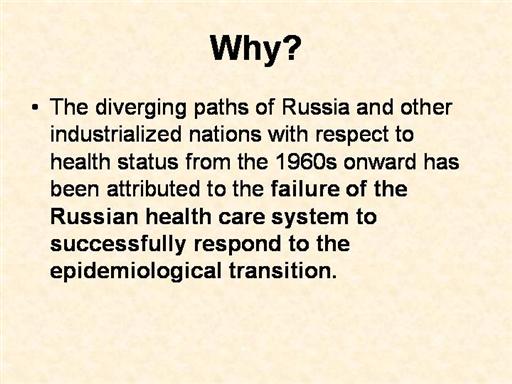| front |1 |2 |3 |4 |5 |6 |7 |8 |9 |10 |11 |12 |13 |14 |15 |16 |17 |18 |19 |20 |21 |22 |23 |24 |25 |26 |27 |28 |29 |30 |31 |32 |33 |34 |35 |36 |37 |38 |39 |40 |41 |42 |43 |44 |45 |46 |47 |48 |49 |50 |51 |52 |review |
 |
In a sense, the very factors making for the
successes of the early years in curbing the spread of infectious
diseases were responsible for the inability to effectively cope with
noncommunicable diseases that were becoming
increasingly important. The Soviet health care system was based
heavily on prevention, consisting of extensive screening measures
and check-ups, although with little evidence for their effectiveness,
which together with the introduction of antibiotics after the Second
World War, contributed to major reductions in infectious diseases. This
system of prevention, with its primarily medical orientation, did not
evolve into one of population-based health promotion measures
necessary for dealing with the new patterns of morbidity (due to
noncommunicable diseases). While those in power were aware that an
epidemiological transition was occurring, they responded by treating
cardiovascular and other noncommunicable diseases as “social diseases”
requiring a medical solution (7).
7. Tulchinsky, T.H. and Varavikova, E.A.
“Addressing the Epidemiologic Transition in the former Soviet Union:
Strategies for health system and
public health reform in Russia” American
Journal of Public Health, Vol. 86, No.3, March 1996.
|